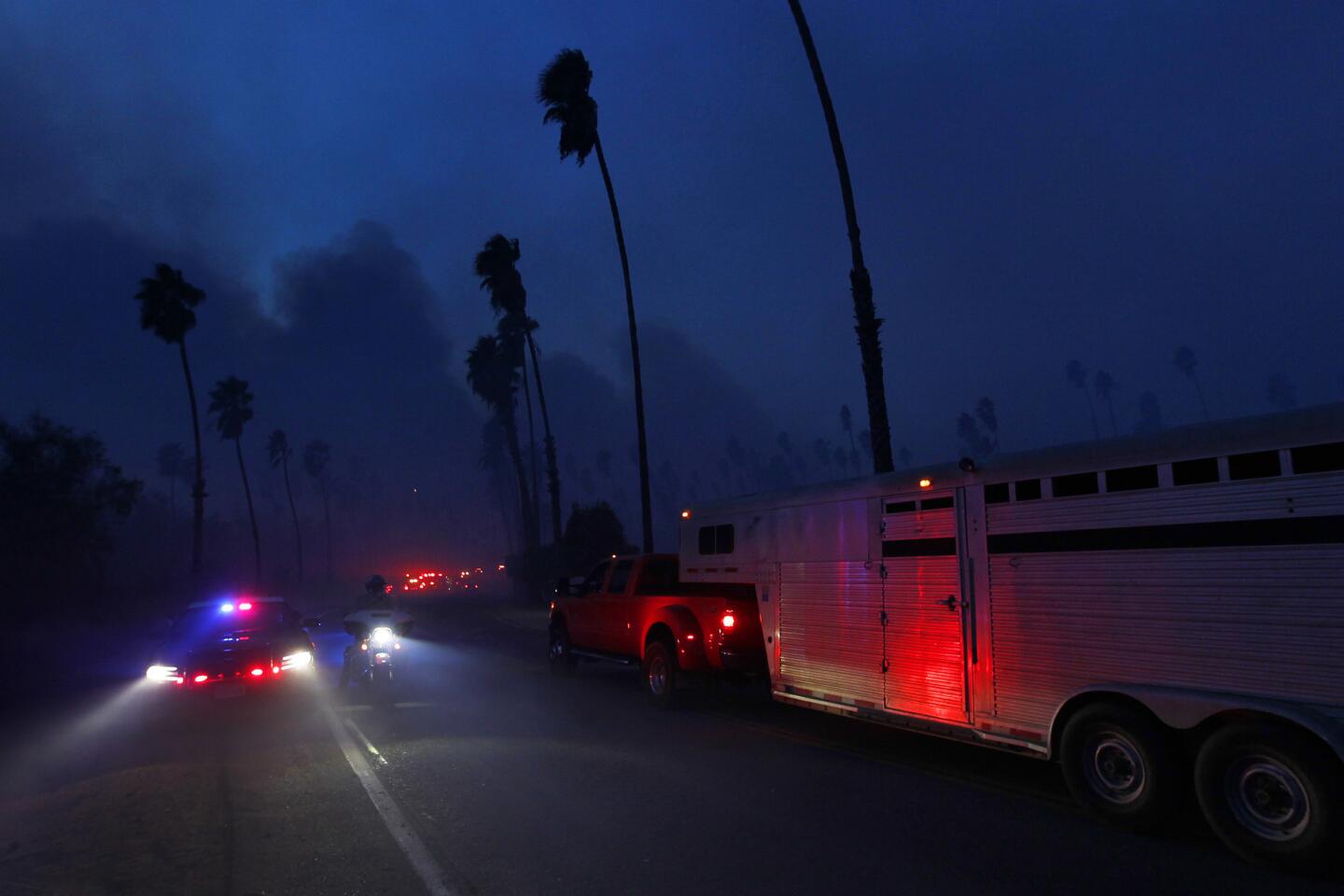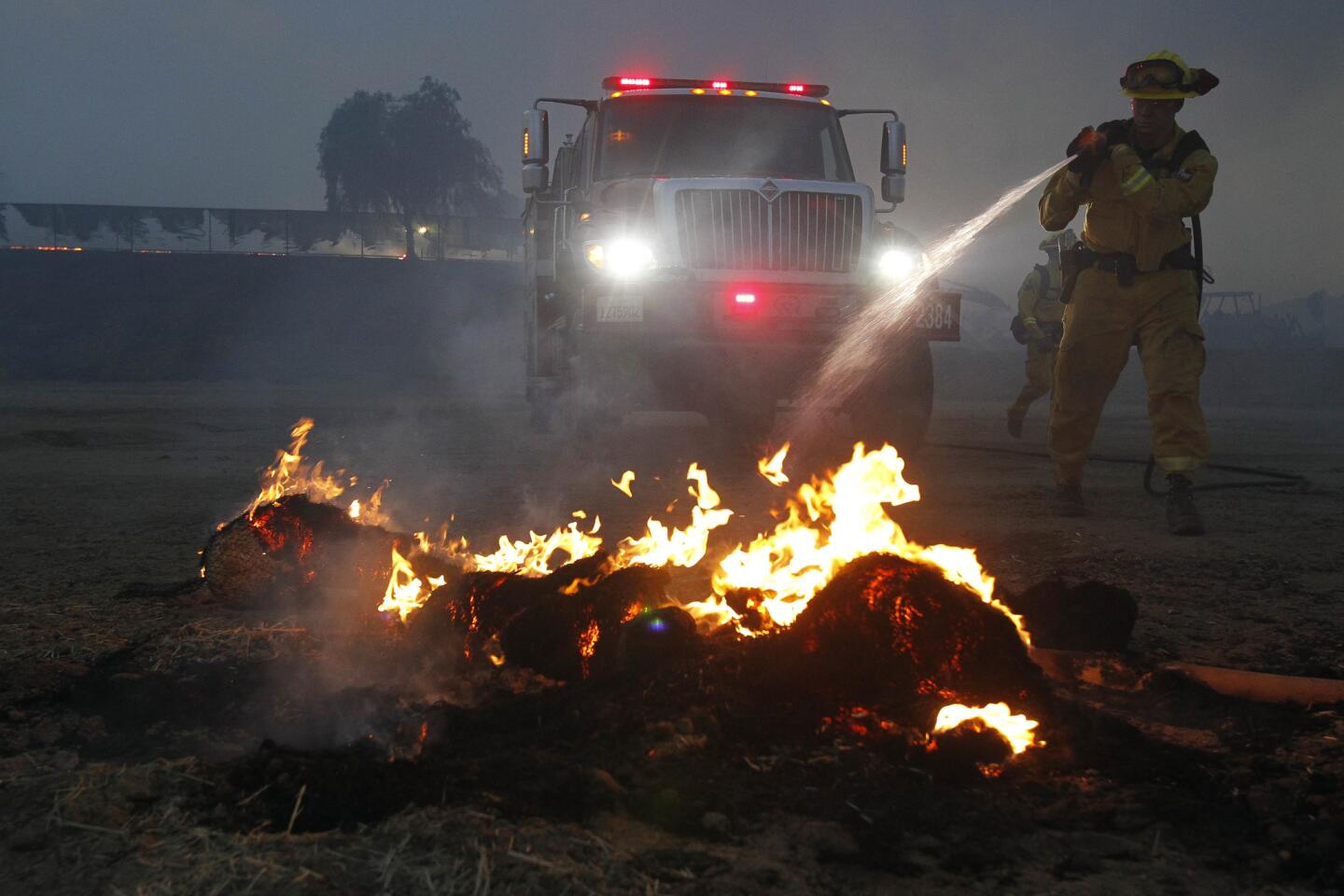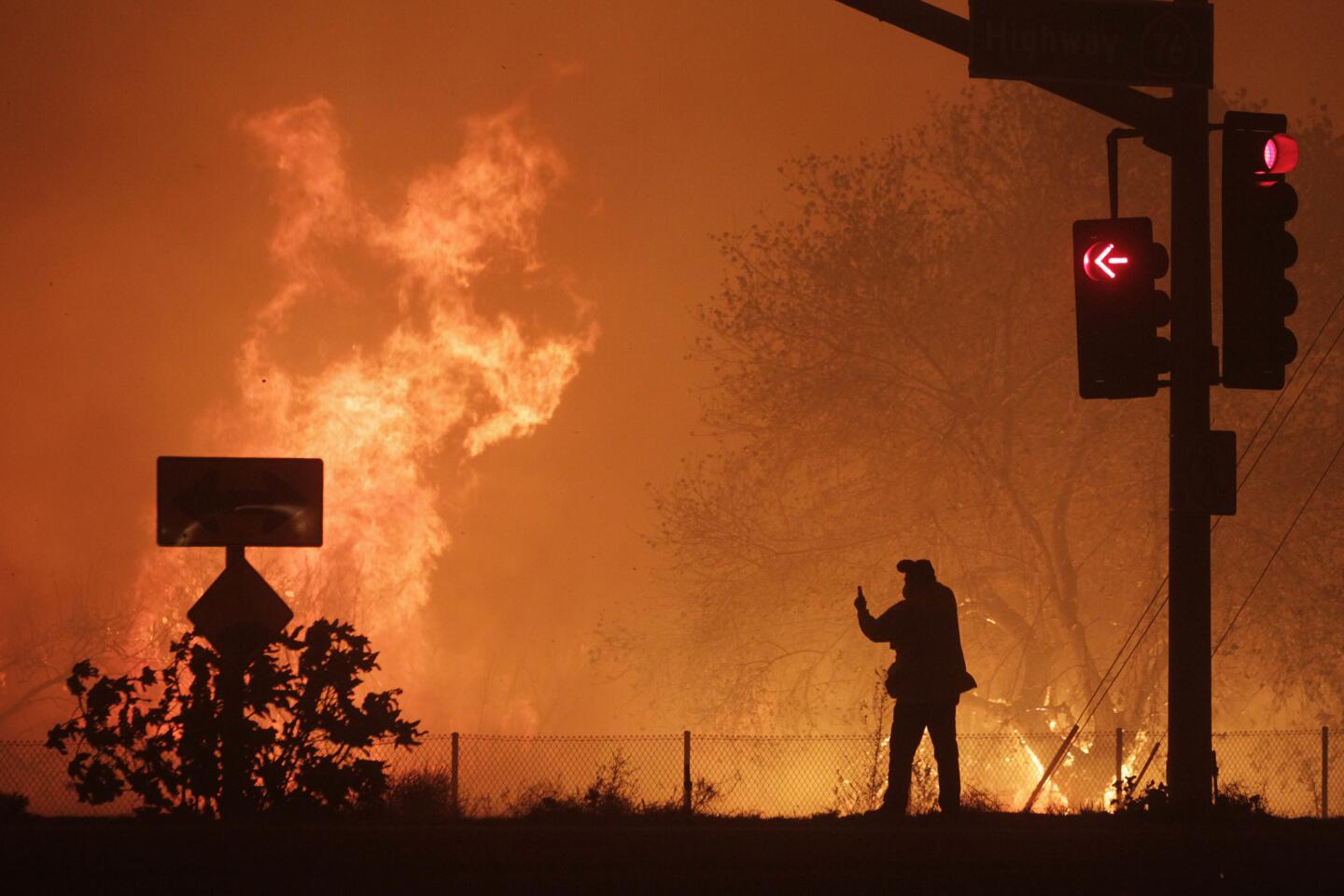California fires: officials made more than 100,000 calls for people to evacuate
NORTH COUNTY — A wildfire fanned by unprecedented December Santa Ana winds was running unchecked across the North County Thursday, chewing through neighborhoods and prompting thousands to flee as the flames spread dangerously fast toward the more populated coast.
By 8 p.m., the Lilac fire had grown to 4,100 acres and had zero containment, adding to the conflagration of wildfires wreaking havoc across Southern California this week.
And as of midnight, county officials confirmed that the county had called more than 100,000 phone numbers to issue evacuation orders or warnings through AlertSanDiego, a regional notification system.
At least three civilians trying to evacuate were injured in the blaze, which roared through Bonsall — a rural community of horses, livestock and agricultural lands — and into Oceanside. A fourth civilian suffered smoke inhalation. Gov. Jerry Brown declared a state of emergency in the county.
“We are in no way near the end of this,” warned Ron Lane, the county’s deputy chief administrative officer who oversees public safety.
Large swaths of Bonsall and Oceanside were evacuated, and authorities warned residents to be on high alert overnight.
“Its incumbent on all the people in this area to stay alert, stay informed and, if you feel it’s important, self-evacuate and get out of the way of this fast-moving fire,” said Sheriff Bill Gore. “...Don’t necessarily wait for that deputy to knock on your door. There aren’t that many of us out there.”
As of about 12:30 a.m. Friday, some 578 people had checked into evacuations centers, a county spokeswoman said.
Evacuation centers in Carlsbad and Oceanside had reached capacity late Thursday, and evacuees were being directed to go to the overnight Red Cross shelter in Escondido at East Valley Community Center, 2245 East Valley Parkway.
At about 2 a.m., officials announced they had opened up a pet-friendly shelter at Palomar College, at 1140 W. Mission Road in San Marcos.
RELATED: Hotels busy taking in evacuees
Authorities confirmed 20 structures have been destroyed and 12 damaged, but witness accounts and news footage made it clear the count was much higher.
As night fell, a shopping center was being consumed by the blaze.
At the Rancho Monserate Country Club, a swath of upscale mobile homes bordering a golf course had already been reduced to ash and twisted metal.
Flames roared through horse barns at the San Luis Rey Downs Training Center. Trainers tried to corral the horses but in the end simply let the panicked animals free — at the risk of being trampled themselves. At least 25 horses reportedly died at the training center in Bonsall, where nearly 500 horses are stabled, officials said.
Streets were choked with good Samaritans hauling horse trailers, offering their services to help comrades evacuate their animals.
Horses were being accepted at the Del Mar Fairgrounds, which had taken in about 500 animals by shortly after midnight.
Some residents decided to stay behind to do what they could. Susie and Michael Lynn stood on the dirt road leading to their home, putting out small spot fires with garden hoses.
The couple were working at the horse training center when they saw a huge cloud of smoke billowing near their neighborhood.
“We saw it getting the better of the firemen and it was heading our way,” said Susie Lynn.
Many roads were closed, including portions of state Route 76 and Old Highway 395.
Eleven school districts will be closed Friday: Bonsall Unified School District, Fallbrook Union Elementary School District, Fallbrook Union High School District, Julian Union Elementary School District, Julian Union High School District, Mountain Empire Unified School District, Oceanside Unified School District, San Marcos Unified School District, Spencer Valley School District, Vista Unified School District and Warner Unified School District as well as Guajome Park Academy, a charter school.
Cal State San Marcos will also be closed, as well as several Palomar College satellite campuses.
The fire was being fed by 35 mph-plus winds, although that’s not nearly as fierce as the strongest gusts in the county Thursday, recorded at 88 mph at Sill Hill near Descanso. The Santa Anas come on the heels of a record-hot summer and are paired with humidity in the single digits.
“These are conditions we haven’t seen in many, many years,” Cal Fire Capt. Kendall Bortisser said.
The conditions were expected to improve overnight, giving firefighters hope they could get ahead of the blaze’s run toward the coast, but onshore winds were anticipated Friday, complicating the situation.
The fire was reported about 11:30 a.m. off Interstate 15 south of state Route 76. The blaze, a couple acres by the time fire crews arrived, quickly grew to 75 acres, then 500.
At least 700 firefighters from agencies across the county were called to duty, as well as two San Diego Fire-Rescue Department helicopters granted permission to fly at night. Tankers and helicopters, including those owned by the military and San Diego Gas and Electric, pitched in with water and retardant drops earlier in the day and were expected to resume at daybreak.
Besides the civilian injuries, one firefighter suffered smoke inhalation. Another who dislocated his shoulder popped it back in and resumed work, authorities said.
Nearly 20,000 SDG&E customers were without power by Thursday afternoon, most affected by the utility’s decision to kill power in backcountry areas experiencing the worst winds. The power in some areas could remain out for the next few days, as the dry, windy conditions have prompted the National Weather Service to extend its red-flag warning through Sunday.
“We have a long road ahead of us,” Cal Fire Battalion Chief Nick Schuler said Thursday night.
The blaze overwhelmed 911 dispatchers, and authorities urged residents to call the county’s 211 line for information on the fire. But the 211 line had its own issues, as several callers reported they could not get through.
Delivery driver Deyanir Helt, 53, was working her route Thursday in the 4S Ranch area while she listened to a police and fire scanner app on her phone. The fire was growing alarmingly close to her home, which sits near the Rancho Monserate community that was burning down.
“The more I heard on the scanner, the worse it got,” Helt said.
The single mother left work a little early, picked up her 5-year-old daughter from school, and they ended up at the East Valley Community Center in Escondido, which was one of three Red Cross overnight shelters. She had fortuitously packed a backpack with some personal belongings for them both a day earlier, after being rattled by small earthquakes in the area — “Just in case of the Big One,” she explained. “We never expected fires.”
She watched the devastation of the mobile home park on the TV news. “I don’t know if I have a home or not, I don’t know,” she said as her daughter played at her feet.
While only small crowds trickled into the shelters by evening, North County hotels were flooded by inquiries from evacuated homeowners trying to find beds.
The brunt of the destruction thus far appeared to be the Rancho Monserate community, an area that dates back to a Mexican land grant in 1846. In 1863 a nine-room ranch house and a chapel was built on the south side of the river. The land around it over the years was bought and sold and eventually turned into a mobile-home park in the 1970s. There are about 230 manufactured homes there now for people ages 55 and older.
Rancho Monserate was no stranger to fire. In May 2014, the Highway fire scorched 380 acres nearby, but spared the park. Residents credited a buffer zone that was cleared between the community and the hill it is tucked against.
Now, dozens of homes there appear have been decimated; a final tally of lost homes was not immediately available. It’s also unknown how the adobe chapel, the only building that remains from the early rancho days, fared in the fire.
Similar destruction is being felt by other Southern California communities, from the Thomas Fire in Ventura County burning more than 500 structures to the Skirball fire torching a handful of Bel-Air mansions.
Also Thursday, massive plumes of smoke shrouded San Diego’s skyline to the south, rising from brush fires burning in Tijuana.
The aggressive spread of flames, and the bone-dry windy conditions, are reminiscent of the last major firestorm to eviscerate large swaths of San Diego County 10 years ago. The 2007 wildfires killed 10 people and destroyed 1,738 homes.
The county is certainly better prepared to fight a fire of this magnitude, reshaping battle tactics following that firestorm and the even deadlier one in 2003. The chief strategy is to hit the fire with overwhelming force from the start.
Also, a uniform dispatch system provides seamless communication between agencies, small volunteer fire districts have been consolidated and strengthened and power lines are even more closely monitored.
Staff writers Teri Figueroa, David Hernandez, John Wilkens, Rob Nikolewski, Gary Robbins, Paul Sisson, Jeff McDonald, J. Harry Jones, Sandra Dibble, Karen Pearlman and City News Service contributed to this story.
Twitter: @LAWinkley
(619) 293-1546
lyndsay.winkley@sduniontribune.com
ALSO
Winds to turn onshore Friday, complicating the battle against Lilac fire
Red flag warning extended as county experiences ‘once in a decade’ style Santa Anas
Sudden firestorm forces deadly stampede at Bonsall training center
UPDATES:
This article was originally published at 11:45 a.m.
More to Read
Sign up for Essential California
The most important California stories and recommendations in your inbox every morning.
You may occasionally receive promotional content from the Los Angeles Times.



















































